The Cambridge History of Japan, Vol. 4: Early Modern Japan
Подождите немного. Документ загружается.


THE CHONIN 765
extravagance and display by
chonin,
both men and women, in clothing
and articles of personal adornment. Prohibitions also appeared against
three-story houses, the use of gold and silver leaf and gold-lacquer
articles, and extravagance in weddings, funerals, memorial services,
and dining and entertainment. These
laws
sought, of
course,
to
curb the
luxurious living of prosperous merchants which, because it was supe-
rior to the comforts enjoyed by samurai, might provoke jealousy and
hence undermine morale and
discipline.
They remained, however, little
more than outbursts of indignation by the ruling class against the pre-
sumptuousness of social inferiors. Because the
laws
were directed at the
display of wealth - attacking as they did the symptoms rather than the
economic causes of fundamental changes in society - they were of lim-
ited effectiveness. But the reminder to
chonin
that they should live like
inferiors, together with a few exemplary confiscations and the frequent
repudiation by daimyo of their enormous debts to merchants, served to
sap some of the exuberance of the more pretentious
chonin.
Such devel-
opments encouraged some
chonin
to reflect again on their proper role
and behavior in Edo society, and to bear in mind Saikaku's warning of
"divine punishment."
114
This theme was taken up by others who wrote words of advice for
chonin. Nishikawa Joken wrote a practical guide called
Chonin bukuro
(A bag of advice for townsmen, 1692), in which he admonishes:
Chonin
are at the bottom of the four classes. . . . Being at the bottom, they
should not exceed their superiors. They should not be envious that others
have prestige and majesty. They should keep to simplicity and plainness and
be content with their status. If they keep to their kind, like oxen enjoy being
with other oxen, they will achieve lifelong enjoyment.
Joken adds the warning: "If lowly
chonin
wear fine clothes and go on
outings, they will be accosted by robbers who will strip them. As
people of humble birth, if they imitate the behavior of their superiors,
they will bring ruinous misfortune on themselves."
115
Ishida Baigan (1685-1744), who formulated a body of social and
ethical teachings for
chonin,
known as
shingaku,
gave advice on which
materials should be worn appropriately to reflect one's status. "Be
grateful for these established forms," he said, "do not violate them, but
observe them strictly. Know the lowliness of
oneself.
It is good to
observe these distinctions.""
6
For Baigan, the avoidance of extravagant
114 Ibid., pp. 126-35. "5 Nihon keizai
sosko,
vol. 5, pp. 65, 67.
116
Tohi mondo
(1739), Akabori Matajiro, ed., in Shingaku
sosho
(Tokyo: Hakubunkan, 1904),
vol. 3, p. 206. On Shingaku, see Robert N. Bellah,
Tokugawa
Religion: The
Values
ofPre-
Industrial Japan (Glencoe,
111.:
Free Press, 1957), pp. 133-77.
Cambridge Histories Online © Cambridge University Press, 2008
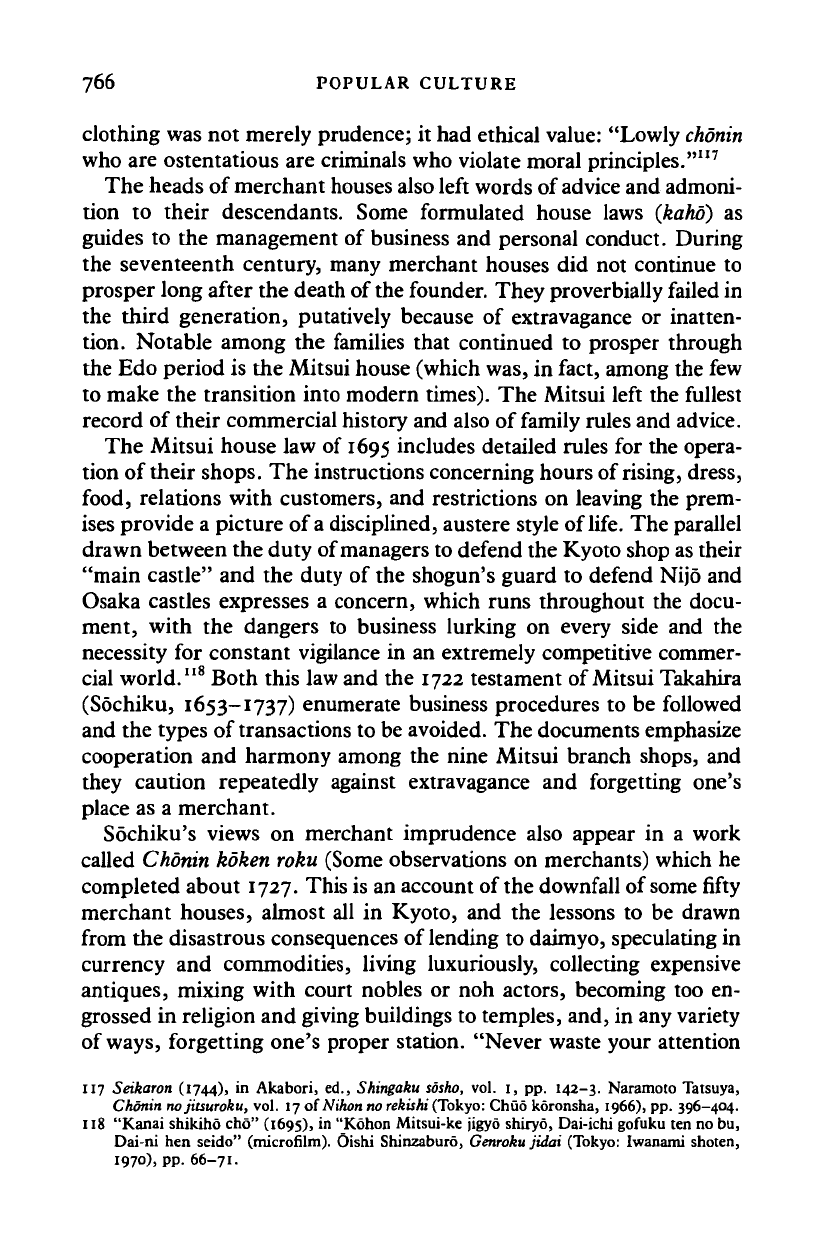
766 POPULAR CULTURE
clothing was not merely prudence; it had ethical value: "Lowly
chonin
who are ostentatious are criminals who violate moral principles."
117
The heads of merchant houses also left words of advice and admoni-
tion to their descendants. Some formulated house laws (kaho) as
guides to the management of business and personal conduct. During
the seventeenth century, many merchant houses did not continue to
prosper long after the death of
the
founder. They proverbially failed in
the third generation, putatively because of extravagance or inatten-
tion. Notable among the families that continued to prosper through
the Edo period is the Mitsui house (which was, in fact, among the few
to make the transition into modern times). The Mitsui left the fullest
record of their commercial history and also of family rules and advice.
The Mitsui house law of 1695 includes detailed rules for the opera-
tion of their shops. The instructions concerning hours of
rising,
dress,
food, relations with customers, and restrictions on leaving the prem-
ises provide a picture of a disciplined, austere style of
life.
The parallel
drawn between the duty of managers to defend the Kyoto shop as their
"main castle" and the duty of the shogun's guard to defend Nijo and
Osaka castles expresses a concern, which runs throughout the docu-
ment, with the dangers to business lurking on every side and the
necessity for constant vigilance in an extremely competitive commer-
cial world."
8
Both this law and the 1722 testament of Mitsui Takahira
(Sochiku, 1653-1737) enumerate business procedures to be followed
and the types of transactions to be avoided. The documents emphasize
cooperation and harmony among the nine Mitsui branch shops, and
they caution repeatedly against extravagance and forgetting one's
place as a merchant.
Sochiku's views on merchant imprudence also appear in a work
called Chonin koken roku (Some observations on merchants) which he
completed about 1727. This is an account of the downfall of
some
fifty
merchant houses, almost all in Kyoto, and the lessons to be drawn
from the disastrous consequences of lending to daimyo, speculating in
currency and commodities, living luxuriously, collecting expensive
antiques, mixing with court nobles or noh actors, becoming too en-
grossed in religion and giving buildings to temples, and, in any variety
of
ways,
forgetting one's proper station. "Never waste your attention
117 Seikaron (1744), in Akabori, ed., Shingaku sosho, vol. 1, pp. 142-3. Naramoto Tatsuya,
Chonin nojitsuroku, vol. 17 of
Nikon
no
rekishi
(Tokyo:
Chuo koronsha, 1966), pp. 396-404.
118 "Kanai shikiho cho" (1695), in "Kohon Mitsui-ke jigyo shiryo, Dai-ichi gofuku ten no bu,
Dai-ni hen seido" (microfilm). Oishi Shinzaburo,
Genroku
jidai (Tokyo: Iwanami shoten,
197°).
PP-
66-71.
Cambridge Histories Online © Cambridge University Press, 2008
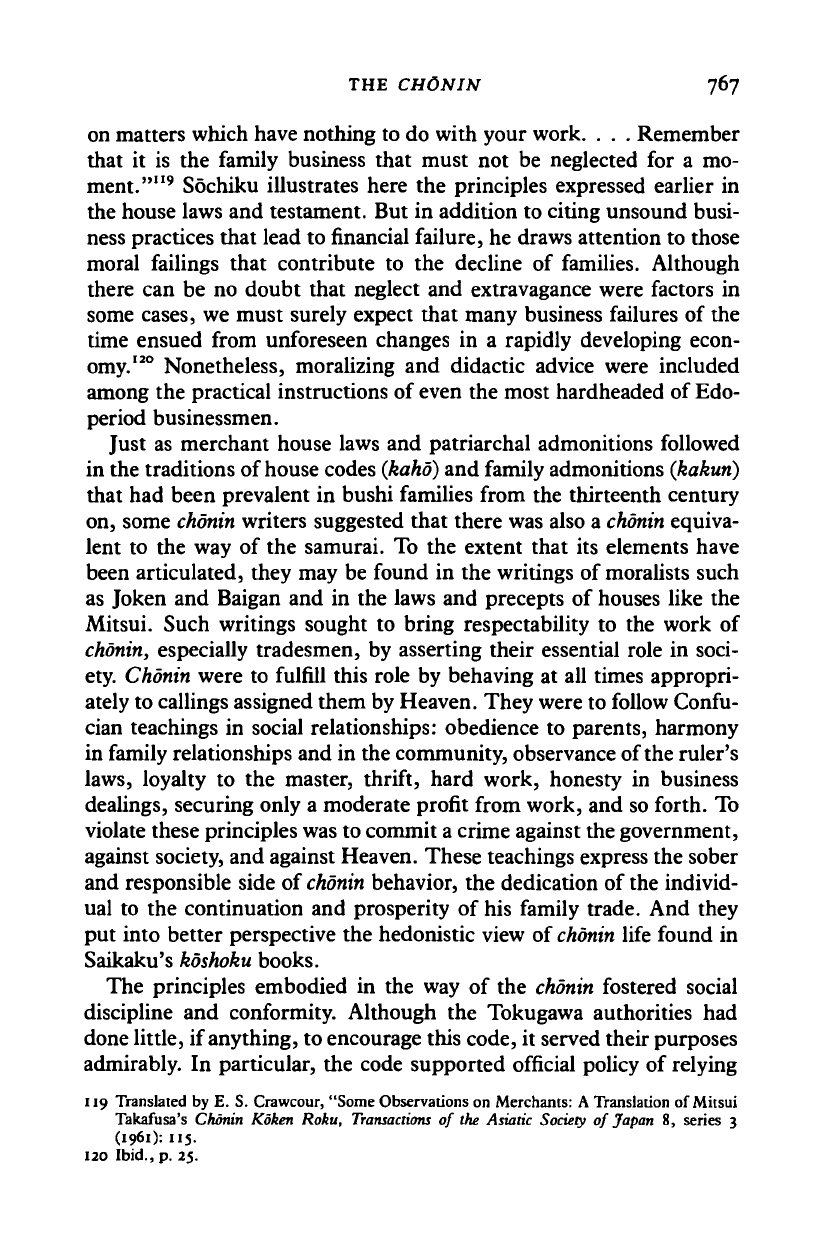
THE CH6NIN 767
on matters which have nothing to do with your work. . . . Remember
that it is the family business that must not be neglected for a mo-
ment."
119
Sochiku illustrates here the principles expressed earlier in
the house laws and testament. But in addition to citing unsound busi-
ness practices that lead to
financial
failure, he draws attention to those
moral failings that contribute to the decline of families. Although
there can be no doubt that neglect and extravagance were factors in
some cases, we must surely expect that many business failures of the
time ensued from unforeseen changes in a rapidly developing econ-
omy.
120
Nonetheless, moralizing and didactic advice were included
among the practical instructions of even the most hardheaded of Edo-
period businessmen.
Just as merchant house laws and patriarchal admonitions followed
in the traditions of house codes
(kaho)
and family admonitions
(kakuri)
that had been prevalent in bushi families from the thirteenth century
on, some
chonin
writers suggested that there was also a
chonin
equiva-
lent to the way of the samurai. To the extent that its elements have
been articulated, they may be found in the writings of moralists such
as Joken and Baigan and in the laws and precepts of houses like the
Mitsui. Such writings sought to bring respectability to the work of
chonin,
especially tradesmen, by asserting their essential role in soci-
ety.
Chonin
were to fulfill this role by behaving at all times appropri-
ately to callings assigned them by Heaven. They were to follow Confu-
cian teachings in social relationships: obedience to parents, harmony
in family relationships and in the community, observance of the ruler's
laws,
loyalty to the master, thrift, hard work, honesty in business
dealings, securing only a moderate profit from work, and so forth. To
violate these principles was to commit a crime against the government,
against society, and against Heaven. These teachings express the sober
and responsible side of
chonin
behavior, the dedication of the individ-
ual to the continuation and prosperity of his family trade. And they
put into better perspective the hedonistic view of
chonin
life found in
Saikaku's
koshoku
books.
The principles embodied in the way of the
chonin
fostered social
discipline and conformity. Although the Tokugawa authorities had
done little, if anything, to encourage this code, it served their purposes
admirably. In particular, the code supported official policy of relying
119 Translated by E. S. Crawcour, "Some Observations on Merchants: A Translation of Mitsui
Takafusa's Chonin Koken Roku, Transactions of the Asiatic Society of Japan 8, series 3
(1961):
115.
120 Ibid., p. 25.
Cambridge Histories Online © Cambridge University Press, 2008
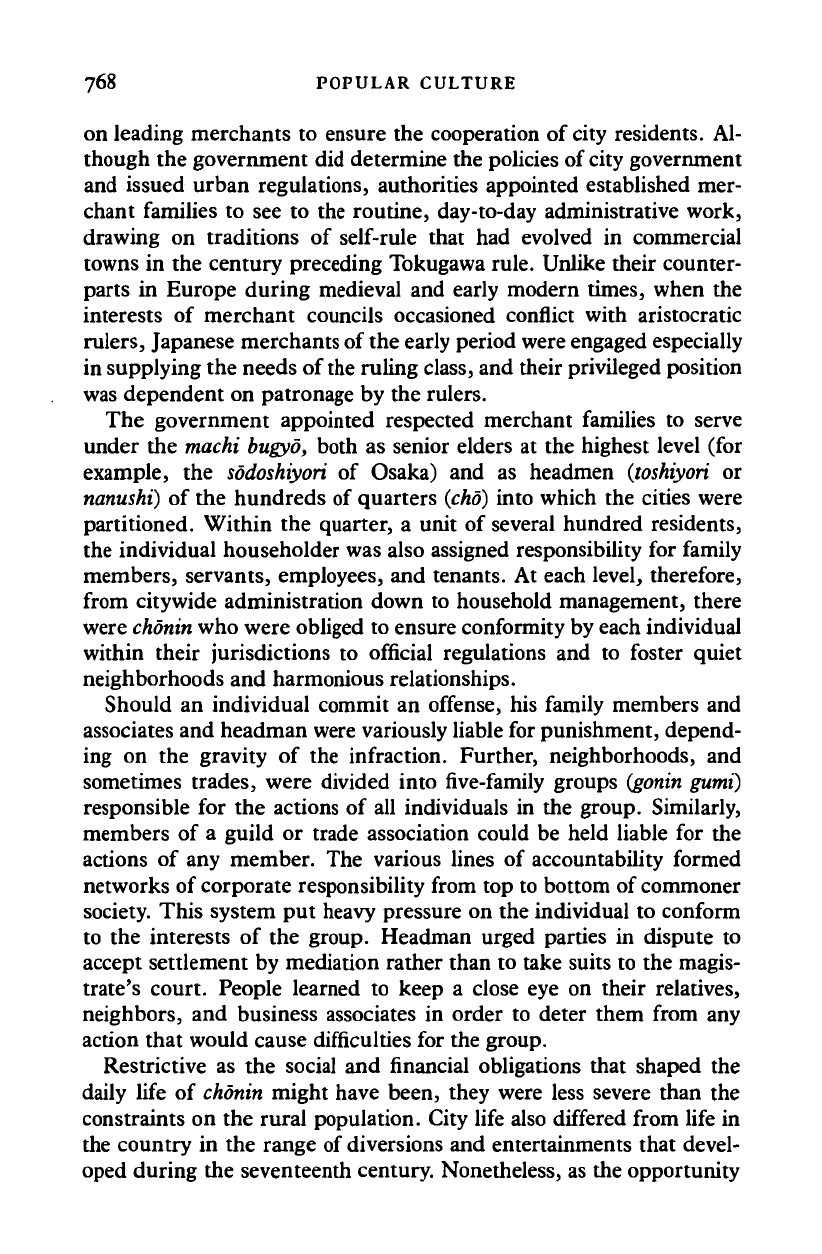
768 POPULAR CULTURE
on leading merchants to ensure the cooperation of city residents. Al-
though the government did determine the policies of city government
and issued urban regulations, authorities appointed established mer-
chant families to see to the routine, day-to-day administrative work,
drawing on traditions of self-rule that had evolved in commercial
towns in the century preceding Tokugawa rule. Unlike their counter-
parts in Europe during medieval and early modern times, when the
interests of merchant councils occasioned conflict with aristocratic
rulers,
Japanese merchants of the early period were engaged especially
in supplying the needs of
the
ruling class, and their privileged position
was dependent on patronage by the rulers.
The government appointed respected merchant families to serve
under the machi
bugyo,
both as senior elders at the highest level (for
example, the
sodoshiyori
of Osaka) and as headmen
(toshiyori
or
nanushi)
of the hundreds of quarters
(cho)
into which the cities were
partitioned. Within the quarter, a unit of several hundred residents,
the individual householder was also assigned responsibility for family
members, servants, employees, and tenants. At each level, therefore,
from city wide administration down to household management, there
were
chonin
who were obliged to ensure conformity by each individual
within their jurisdictions to official regulations and to foster quiet
neighborhoods and harmonious relationships.
Should an individual commit an offense, his family members and
associates and headman were variously liable for punishment, depend-
ing on the gravity of the infraction. Further, neighborhoods, and
sometimes trades, were divided into five-family groups
(gonin
gumi)
responsible for the actions of all individuals in the group. Similarly,
members of a guild or trade association could be held liable for the
actions of any member. The various lines of accountability formed
networks of corporate responsibility from top to bottom of commoner
society. This system put heavy pressure on the individual to conform
to the interests of the group. Headman urged parties in dispute to
accept settlement by mediation rather than to take suits to the magis-
trate's court. People learned to keep a close eye on their relatives,
neighbors, and business associates in order to deter them from any
action that would cause difficulties for the group.
Restrictive as the social and financial obligations that shaped the
daily life of
chonin
might have been, they were less severe than the
constraints on the rural population. City life also differed from life in
the country in the range of diversions and entertainments that devel-
oped during the seventeenth century. Nonetheless, as the opportunity
Cambridge Histories Online © Cambridge University Press, 2008
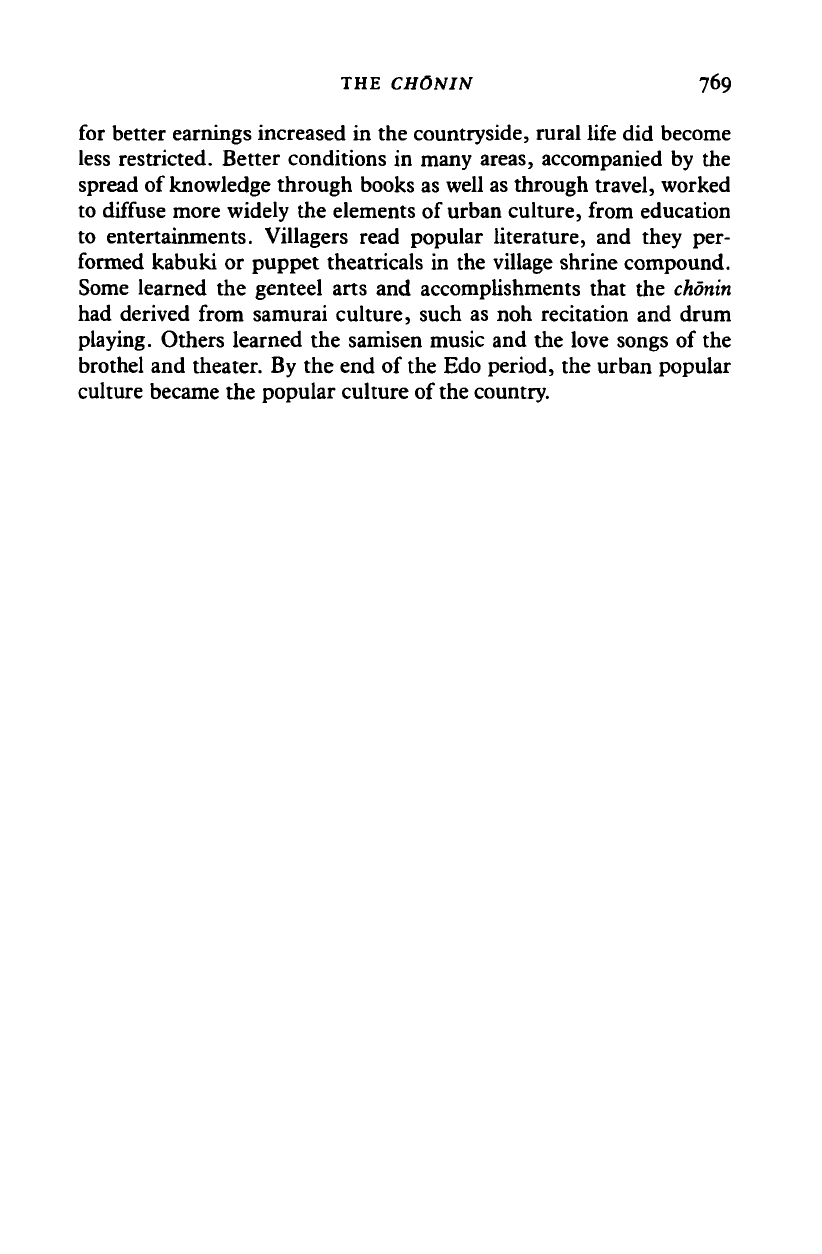
THE CHONIN 769
for better earnings increased in the countryside, rural life did become
less restricted. Better conditions in many areas, accompanied by the
spread of knowledge through books as well as through travel, worked
to diffuse more widely the elements of urban culture, from education
to entertainments. Villagers read popular literature, and they per-
formed kabuki or puppet theatricals in the village shrine compound.
Some learned the genteel arts and accomplishments that the
chonin
had derived from samurai culture, such as noh recitation and drum
playing. Others learned the samisen music and the love songs of the
brothel and theater. By the end of the Edo period, the urban popular
culture became the popular culture of the country.
Cambridge Histories Online © Cambridge University Press, 2008
Cambridge Histories Online © Cambridge University Press, 2008
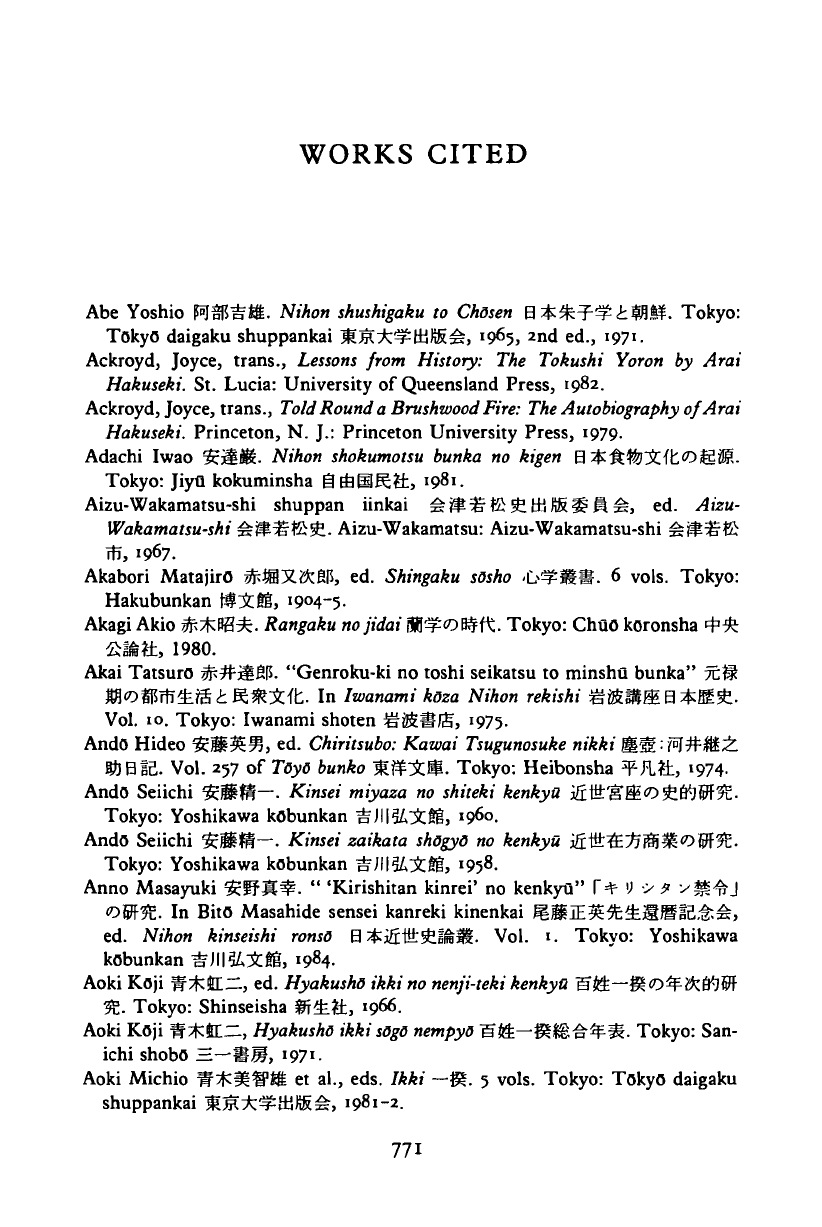
WORKS CITED
Abe Yoshio
TO^lf.
Nihon shushigaku
to
Chosen
BX^^tWim.
Tokyo:
Tokyo daigaku shuppankai
iM^fffiffi^,
1965*
2
"d ed., 1971.
Ackroyd, Joyce, trans.,
Lessons
from History: The Tokushi Yoron by Arai
Hakuseki. St. Lucia: University of Queensland Press, 1982.
Ackroyd, Joyce, trans.,
Told
Round
a Brushwood
Fire:
The Autobiography
of Arai
Hakuseki. Princeton, N. J.: Princeton University Press, 1979.
Adachi Iwao 3?j§l£. Nihon shokumotsu bunka no kigen B^j^iffcdiajg.
Tokyo:
Jiytl kokuminsha g&SKtfc, 1981.
Aizu-Wakamatsu-shi shuppan iinkai #i^:£f$&!fetB)i£3m6j ed. Aizu-
Wakamatsu-shi
#ft3H££L. Aizu-Wakamatsu: Aizu-Wakamatsu-shi £&%;&
m, 1967.
Akabori MatajirO ^SiXftcfiP, ed. Shingaku sdsho
-il^iRlf.
6 vols. Tokyo:
Hakubunkan
W~$.ffe>
1904-5.
Akagi Akio ^*Pg^c. Rangaku nojidai Sfi^©B$ft. Tokyo: ChuO koronsha
&»a, 1980.
Akai Tatsuro ^#ji!g|$. "Genroku-ki no toshi seikatsu to minshu bunka"
M<r>m?n$Lt&tRn-X\t. In Iwanami kdza Nihon rekishi %&
Vol.
10. Tokyo: Iwanami shoten S&llJS, 1975.
AndO Hideo
^JSI^S-f;,
ed.
Chiritsubo:
Kawai
Tsugunosuke
nikki
BtJBffi. Vol. 257 of Toyd bunko ^ff:£S. Tokyo: Heibonsha ^M±, 1974.
AndO Seiichi $!§fS—. Kinsei miyaza no shiteki kenkyu jB
Tokyo:
Yoshikawa kobunkan ^Jll^i^Itg, i960.
AndO Seiichi tiMWt—. Kinsei zaikata
shdgyO
no kenkyu
Tokyo:
Yoshikawa kobunkan ^ill^i^gg, 1958.
Anno Masayuki $ifK^. " 'Kirishitan kinrei' no kenkyu"
S
*
V
>
<o5f5E. In BitO Masahide sensei kanreki kinenkai
^WJE^^t^.SMtiM'^,
ed. Nihon kinseishi ronsd 0;£ifitt5EiIi%3t. Vol. 1. Tokyo: Yoshikawa
kobunkan &\\m&&, 1984.
Aoki Koji W^ttn, ed. Hyakushd ikkino
nenji-teki
kenkytt •§•&—^«O^i!*:^)if
^E.
Tokyo: Shinseisha |Ff^?±, 1966.
Aoki Koji ff^lLZl, Hyakusho ikki
sOgO nempyO
S&—gl^^-^S- Tokyo: San-
ichi shobo
=.—9W,
«97«.
Aoki Michio W^HS^ et al., eds. Ikki —g|. 5 vols. Tokyo: Tokyo daigaku
shuppankai ^«*^tti)S^, 1981-2.
771
Cambridge Histories Online © Cambridge University Press, 2008

772 WORKS CITED
Aono Shunsui Wif#*.
DaimyO
to
ryOmin jz%>
t ®H. Tokyo: KyOikusha ifcW
a, 1983.
Araki Kengo ^^MS and Inoue Tadashi #±,$>, eds. Kaibara Ekken - Muro
Kyaso HH&ff-^iSli. Vol. 34 of Nihon shisS taikei B*,Si®*^. Tokyo:
Iwanami shoten
^iS.^!S,
I
97°-
Araki Moriaki 9cJ^$c§S08. Bakuhan taisei shakai no seiritsu to
kozO
^Ogciti^jg. Tokyo: Ochanomizu shobO
M^^yKWW,
'959-
Araki Moriaki 2c&&&B8. TaikO kenchi to kokudakasei
Tokyo: Nihon hosO shuppan kyOkai B^Wc^tHfS.Wi^, i9
6
9, 1982.
Arano Yasunori j^ffSft. "Taikun gaiko taisei no kakuritsu"
ft. In KatO Eiichi
tvM^—
and Yamada Tadao OjffltfJi, eds. Sakoku glS.
Vol. 2 of Kdza Nihon kinseishi m@£.a*&W$.. Tokyo: Yuhikaku *§g[»,
1981.
Aruga Kizaemon ^KtfSflJF'j. "Hotoke to iu kotoba ni tsuite" -+- l-yil-51
3£MOI>-C. In Takeda ChOshu
S;fflBijm,
ed. Senzo
kuyO
*fflW*. Vol. 3 of
Sdso
bosei kenkyQ
shusei PJiS^JP^Eft^c. Tokyo: Meicho shuppan Z^ttiffc.,
•979-
Asakawa, Kan'ichi, trans, and ed.
The
Documents of Iriki. Tokyo: Japan Society
for the Promotion of Science, 1955.
Asakawa, Kan'ichi. Land and
Society
in Medieval Japan. Tokyo: Japan Society
for the Promotion of Science, 1965.
Asakura Haruhiko ^#?ni^, ed. Azuma monogatari £>o*£%ig. Vol.
1
of Kana
zoshi shusei (g^^^-^fiSc. Tokyo: TokyOdO
JCM^,
1980.
Asao Naohiro 48BjS?A. Kinsei hoken shakai no kiso
kozO
ifittrttHa^O^^ft
jg.
Tokyo: Ochanomizu shobO
'ffl^<D7k9M,
>9
6
7.
Asao Naohiro $JJ!ljii[3£. " 'Kinsei' no hajimari - Higashi Ajia no keizai hendo
to sankasei." r^fiffiJ
<Oii
Ci
*)
-$7 J7<D&i(%mW) t =M%L Zusetsu
Nihon bunkashi taikei,
geppO
121180*Xfk***, ^^8 (1066).
Asao Naohiro SISiK&. Sakoku Mm. Tokyo: ShOgakkan /J^fig, 1975.
Asao Naohiro ^SH^A. "Sakoku no seiritsu" IJHOsKiz:. In Rekishigaku
kenkyukai M^^W^E^ and Nihonshi kenkyQkai
S*^W%^,
eds.
Bakuhansei shakai BM%ftk£. Vol. 4 of Kdza Nihonshi ^ffiS*£. Tokyo:
Tokyo daigaku shuppankai ^M^^ttiJiS^, i97°-
Asao Naohiro m^U^L. "Shogun kenryoku no sOshutsu" mW^tl<oMlii. Pts.
1-3. Rekishi
hydron
BfStJFFlt
241
(August 1970): 70-78; 266 (August 1972): 46-
59;
and 293 (September 1974): 20-36.
Asao Naohiro 3PJftit3£. "ShOgun seiji no kenryoku k6zO" ^W&L^<O^tiW&.
In Iwanami kdza Nihon rekishi Si&SISEB^BIS. Vol. 10. Tokyo: Iwanami
shoten SffiilJS,
*975-
Asao Naohiro ^BSttsii. "Toyotomi seiken ron" SEBcHlw. In Iwanami kdza
Nihon rekishi gig^ffiB#g£. Vol. 9. Tokyo: Iwanami shoten g&«J£,
1963.
Asao,
Naohiro, with Marius
B.
Jansen. "Shogun and TennO." In John W. Hall,
Keiji Nagahara, and Kozo Yamamura, eds. Japan Before Tokugawa: Political
Cambridge Histories Online © Cambridge University Press, 2008
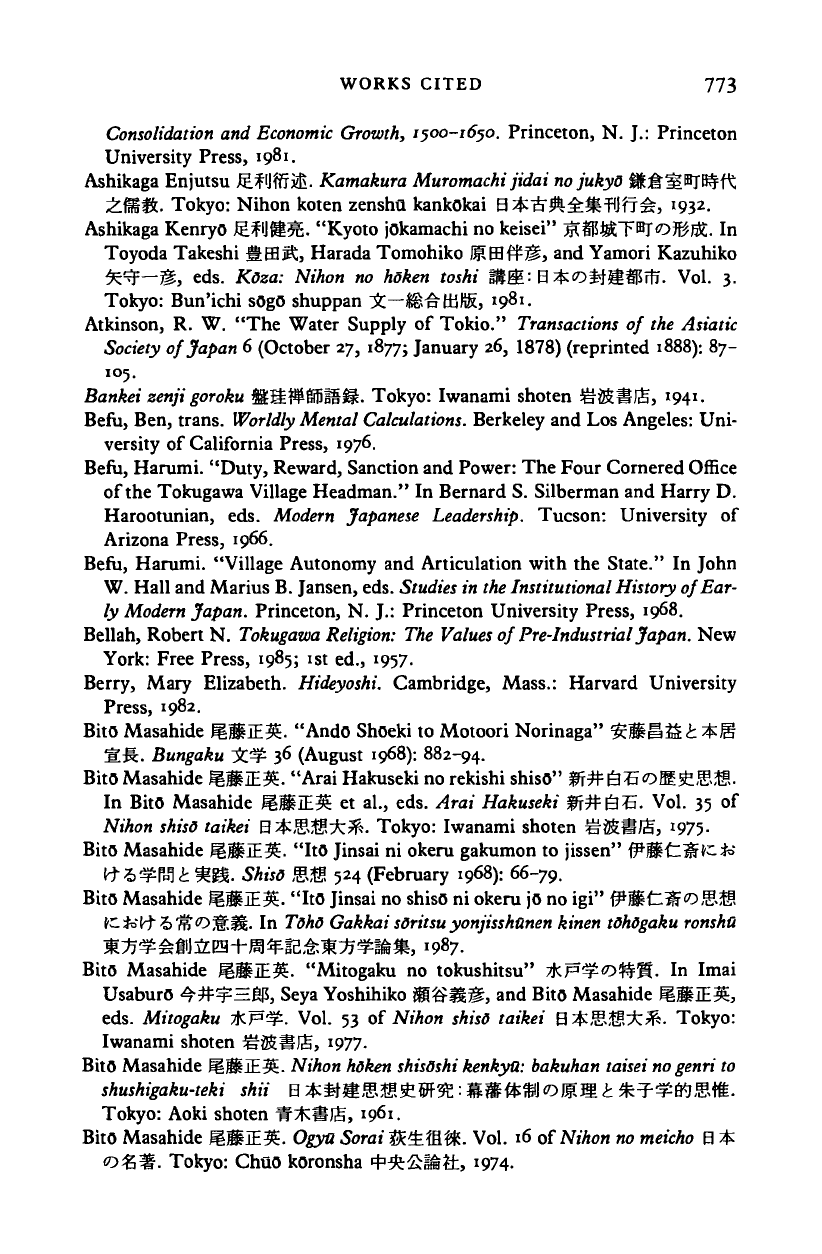
WORKS CITED 773
Consolidation and Economic
Growth,
1500-1650.
Princeton, N. J.: Princeton
University Press, 198'.
Ashikaga Enjutsu JE.flJfff«E.
Kamakura
Muromachi jidai
no jukyO
^^gBIBtf^;
£flit Tokyo: Nihon koten zenshu kankokai 0 **ft£^fljff £, 1932.
Ashikaga KenryO J£#IJ(SIE. "Kyoto jokamachi no keisei" ^S$$rFBJ£>}iM. In
Toyoda Takeshi ftfflSS, Harada Tomohiko HEBffi^, and Yamori Kazuhiko
^3=—H.,
eds.
KOza:
Nihon no hsken toshi
M&'-
0*<Oifi*f|5rfT. Vol. 3.
Tokyo: Bun'ichi
sOgO
shuppan £—i^ffiJig, 1981.
Atkinson, R. W. "The Water Supply of Tokio."
Transactions
of
the
Asiatic
Society
of
Japan 6
(October 27,
1877;
January 26, 1878) (reprinted 1888): 87-
105.
Banker zenji goroku
$£3£#&fil§li. Tokyo: Iwanami shoten SKllJS, 1941.
Befu, Ben, trans.
Worldly Mental
Calculations.
Berkeley and Los Angeles: Uni-
versity of California Press, 1976.
Befu, Harumi. "Duty, Reward, Sanction and Power: The Four Cornered Office
of the Tokugawa Village Headman." In Bernard S. Silberman and Harry D.
Harootunian, eds. Modern
Japanese
Leadership.
Tucson: University of
Arizona Press, 1966.
Befu, Harumi. "Village Autonomy and Articulation with the State." In John
W. Hall and Marius
B.
Jansen,
eds.
Studies in the Institutional History
of Ear-
ly
Modern
Japan.
Princeton, N. J.: Princeton University Press, 1968.
Bellah, Robert N.
Tokugawa
Religion:
The
Values
of Pre-Industrial Japan. New
York: Free Press, 1985; 1st ed., 1957.
Berry, Mary Elizabeth.
Hideyoshi.
Cambridge, Mass.: Harvard University
Press,
1982.
Bito Masahide BJSIE3?. "AndO Shoeki to Motoori Norinaga"
m.&.
Bungaku
Sn^ 36 (August 1968): 882-94.
BitO
Masahide
mMTEZh.
"Arai Hakuseki no rekishi shisO"
In BitO Masahide MMiE^ et al., eds. Arai
Hakuseki
ff#6£. Vol. 35 of
Nihon shisd
taikei 0 ^ffiiffl^:^. Tokyo: Iwanami shoten S2£ll/£, 1975-
BitO
Masahide SJHIE^. "ItO Jinsai ni okeru gakumon to jissen"
H-^^raiH^.
Shisd
Si® 524 (February 1968): 66-79.
BitO
Masahide SsIglE^. "ItO Jinsai no shisO ni okeru jo no igi"
- In
TohO
GakkaisOritsuyonjisshunen kinen tdhdgaku ronshu
^^ia.t:S^#lr*, 1987.
BitO Masahide SHIIE3I. "Mitogaku no tokushitsu" iKP^<O^'R. In Imai
UsaburO 4-#^^fiP, Seya Yoshihiko
M'&HTB, and
BitO
Masahide gJUJEH,
eds.
Mitogaku *P^. Vol. 53 of
Nihon shisd
taikei B^^M~k^- Tokyo:
Iwanami shoten SKS/£, '977-
BitO Masahide ^B£IE3S. Nihon hoken
shisOshi
kenkytt: bakukan taisei
no genri
to
shushigaku-teki shii
Tokyo: Aoki shoten
BitO Masahide S§1£IE3I.
Ogya Sorai
$£ffi#5. Vol.
16
of
Nihon no tneicho
0 *
f. Tokyo: ChuO kOronsha "^^Slitt, 1974-
Cambridge Histories Online © Cambridge University Press, 2008
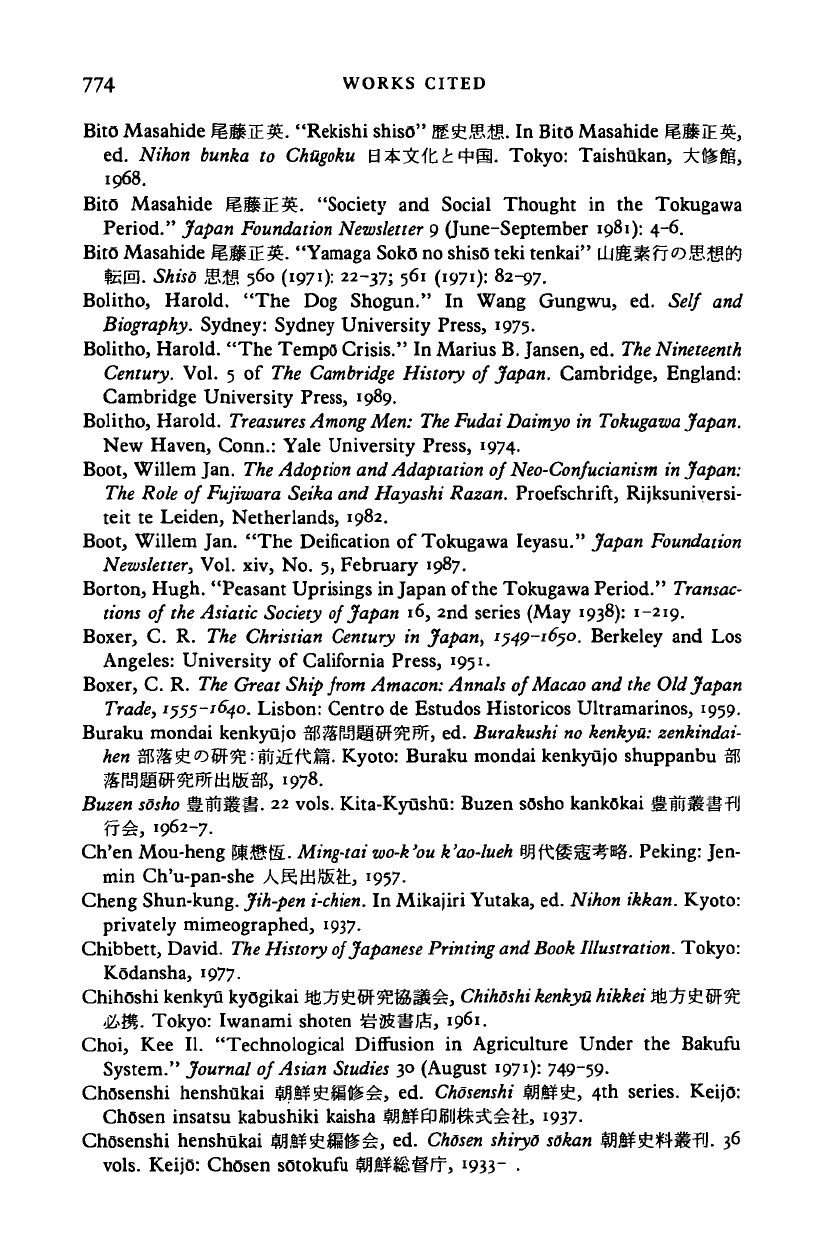
774 WORKS CITED
BitO Masahide MHIE3?. "Rekishi shisO" E£,ilig. In BitO Masahide m
ed. Nihon bunka to Chagoku
B
^ifc-ft £ 4>H- Tokyo: Taishukan,
1968.
BitO Masahide BHIE3?. "Society and Social Thought in the Tokugawa
Period." Japan Foundation Newsletter 9 (June-September 1981): 4-6.
BitO Masahide ®HiE3S. "Yamaga SokO no shisO teki tenkai" \l\WMfs<O^M^}
te@. Shiso B,M 560
(1971):
22-37; 561 (1971): 82-97.
Bolitho, Harold. "The Dog Shogun." In Wang Gungwu, ed. Self and
Biography. Sydney: Sydney University Press, 1975.
Bolitho, Harold. "The Tempo Crisis." In Marius B. Jansen, ed. The Nineteenth
Century. Vol. 5 of The Cambridge History of Japan. Cambridge, England:
Cambridge University Press, 1989.
Bolitho, Harold.
Treasures
Among Men: The Fudai Daimyo in
Tokugawa
Japan.
New Haven, Conn.: Yale University Press, 1974.
Boot, Willem Jan. The Adoption and Adaptation of
Neo-Confucianism
in Japan:
The Role of Fujiwara Seika and Hayashi Razan. Proefschrift, Rijksuniyersi-
teit te Leiden, Netherlands, 1982.
Boot, Willem Jan. "The Deification of Tokugawa Ieyasu." Japan Foundation
Newsletter, Vol. xiv, No. 5, February 1987.
Borton, Hugh. "Peasant Uprisings in Japan of the Tokugawa Period." Transac-
tions of the Asiatic Society
of
Japan 16, 2nd series (May 1938):
1-219.
Boxer, C. R. The Christian Century in Japan, 1549-1650. Berkeley and Los
Angeles: University of California Press, 1951.
Boxer, C. R. The Great Ship from Amacon: Annals of Macao and the
Old
Japan
Trade, 1555-1640. Lisbon: Centro de Estudos Historicos Ultramarinos, 1959.
Buraku mondai kenkyujo afSJSfoiJliWifEfi'f, ed. Burakushi no kenkytt: zenkindai-
hen a(5^S<oW^E:HtlififtjR. Kyoto: Buraku mondai kenkyujo shuppanbu 95
Buzen
sosho
HfiJ^fH. 22 vols. Kita-Kyushu: Buzen sOsho kankokai jSfilSHlfll
fr£,
1962-7.
Ch'en Mou-heng gS$g. Ming-tai wo-k'ou k'ao-lueh BJf^g^%ffl§. Peking: Jen-
min Ch'u-pan-she ARttiJKS:, '957-
Cheng Shun-kung. Jih-pen
i-chien.
In Mikajiri Yutaka, ed. Nihon ikkan. Kyoto:
privately mimeographed, 1937.
Chibbett, David. The History of Japanese Printing and Book Illustration. Tokyo:
Kodansha, 1977-
ChihOshi kenkyu kyOgikai S&fitWRM'^'k,
ChihOshi
kenkyu hikkeitfeJ]&.Wft
iftSS.
Tokyo: Iwanami shoten Sz&llJS,
i9
6t
-
Choi, Kee II. "Technological Diffusion in Agriculture Under the Bakufu
System." Journal of Asian Studies 30 (August i97i)
:
749~59-
ChOsenshi henshukai $BS¥s£S1&£, ed. Chosenshi $HI¥£, 4th series. KeijO:
Chosen insatsu kabushiki kaisha ^SI^EPBUttSsS:, *937-
ChOsenshi henshukai mM%.M&£, ed. Chdsen
shiryO sOkan
mm^PiM^l 3
6
vols.
Keijo: Chosen sOtokufu
MWW&igfT,
1933- •
Cambridge Histories Online © Cambridge University Press, 2008
